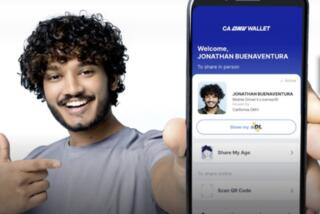California Commute: Antelope Valley Transit Authority experiments with digital ads on buses
At first glance, the vivid advertisement on the side of the bus seemed familiar enough:
“Injured?”
Then, in a ripple of pixels, the message changed.
“We can help!”
“It’s bright, isn’t it?” said Jennifer Lutz, 32, of Los Angeles, as she stood on the sidewalk on Wilshire Boulevard in Mid-City, eyeing the bus idling at the opposite curb. Seconds later, the kayak-sized digital screen changed once more, to display the phone number for a personal injury attorney. “It really gets your attention.”
Several major U.S. cities, including New York and Chicago, have experimented with digital ads on buses, but this Antelope Valley Transit Authority commuter bus is the first of its kind in California. As part of a pilot program approved by the Legislature, the agency will swap vinyl banner ads for digital panels on as many as 30 buses over the next five years.
Other cash-strapped California transit agencies, facing rising operating costs, are watching the potentially lucrative test run with interest, officials say: Currently, state law restricts digital signage on buses to route and service information. But some regulators have voiced safety concerns, saying moving ads on the driver’s side of the bus, at eye-level, could distract drivers from the road.
“There are probably 10 things that you can do in the car that are more distracting than looking at an ad,” said Rep. Steve Knight (R-Palmdale), who sponsored the bill that legalized the ads when he was in the state Senate. But he said the ads need to be tested and studied before it’s clear what effect they have on drivers, he said.
The digital panels are incorporated into an ad that covers the entire bus. The full package costs the advertiser nearly $20,000 a month — several thousand dollars more than an ad that covers the bus, and 40 times more than a standard banner ad, said Ely Sorkin, chief executive of the company that sells Antelope Valley Transit Authority’s ads.
“You get real-time, dynamic information,” Sorkin said. “They’re very avant-garde.”
The law bans images and text that blink or scroll too quickly. Full video ads are probably out of the question, officials say.
The first bus featuring the digital panels carries Antelope Valley commuters through some of Los Angeles County’s poshest neighborhoods, including Beverly Hills and Hancock Park, and passes by tourist hot spots on Rodeo Drive and the Hollywood Walk of Fame. The digital ads will reach more than 400,000 people a month in the country’s second-largest advertising market, according to advertiser estimates.
A digital sign costs about $50,000 to install, and runs on the bus’ electrical system. The ads are particularly popular with major brands, Sorkin said, because they can communicate with customers in real time, from showing winning lottery numbers to teasing the lead story on the nightly news.
Aside from advertising, Knight said, the panels could also serve the public interest. In the event of an Amber Alert, he said, the buses could display the make and model of the car in which a missing child was last seen.
Two years ago, Santa Monica’s Big Blue Bus system weighed a similar program, which would have allowed it to install digital panels on 30 buses. But the initiative was scrapped after officials raised questions about finances, safety and aesthetics.
Officials heard mixed reviews from other transit agencies that had tried digital ad programs, said Suja Lowenthal, the government and community relations manager for Big Blue Bus and the vice mayor of Long Beach. And if a digital sign were to be damaged in a crash, she said, repairs would be more expensive.
At the time, Los Angeles officials asked Santa Monica to keep the ads out of L.A.
“We have serious concerns about the public’s safety in the face of large, rapidly changing or streaming signs moving at speed on city streets,” then-Los Angeles City Atty. Carmen Trutanich wrote in a 2011 letter. Funding public transportation, he wrote, “cannot come at the safety of drivers, passengers, cyclists, pedestrians or the environment.”
A representative for current City Atty. Mike Feuer did not respond to questions over whether Antelope Valley’s program raised similar issues.
The aesthetic implications are also troubling, said Dennis Hathaway, president of the Coalition to Ban Billboard Blight.
“Do you want people sitting in traffic, watching signs on the side of buses, instead of watching where they’re going?” Hathaway said. “They’re designed to distract people. If they didn’t distract people, they would have no point.”
Knight’s law requires the Antelope Valley Transit Agency and the California Highway Patrol to study the effects on driver and pedestrian safety, “if any,” and report their findings in 2020. That will probably include asking drivers involved in crashes with the buses, or near them, whether the ads were a factor, Knight said.
“In the end, I don’t think they’ll find any information that shows that they’re a danger to the community,” Knight said. “My belief is that the program will expand, and it will do very well across the state as a way for agencies to make more money.”
For more transportation news, follow @laura_nelson on Twitter.
Have an idea, gripe or question? Times staff writers Laura J. Nelson and Dan Weikel write California Commute and are looking for leads. Send them along.
More to Read
Sign up for Essential California
The most important California stories and recommendations in your inbox every morning.
You may occasionally receive promotional content from the Los Angeles Times.











